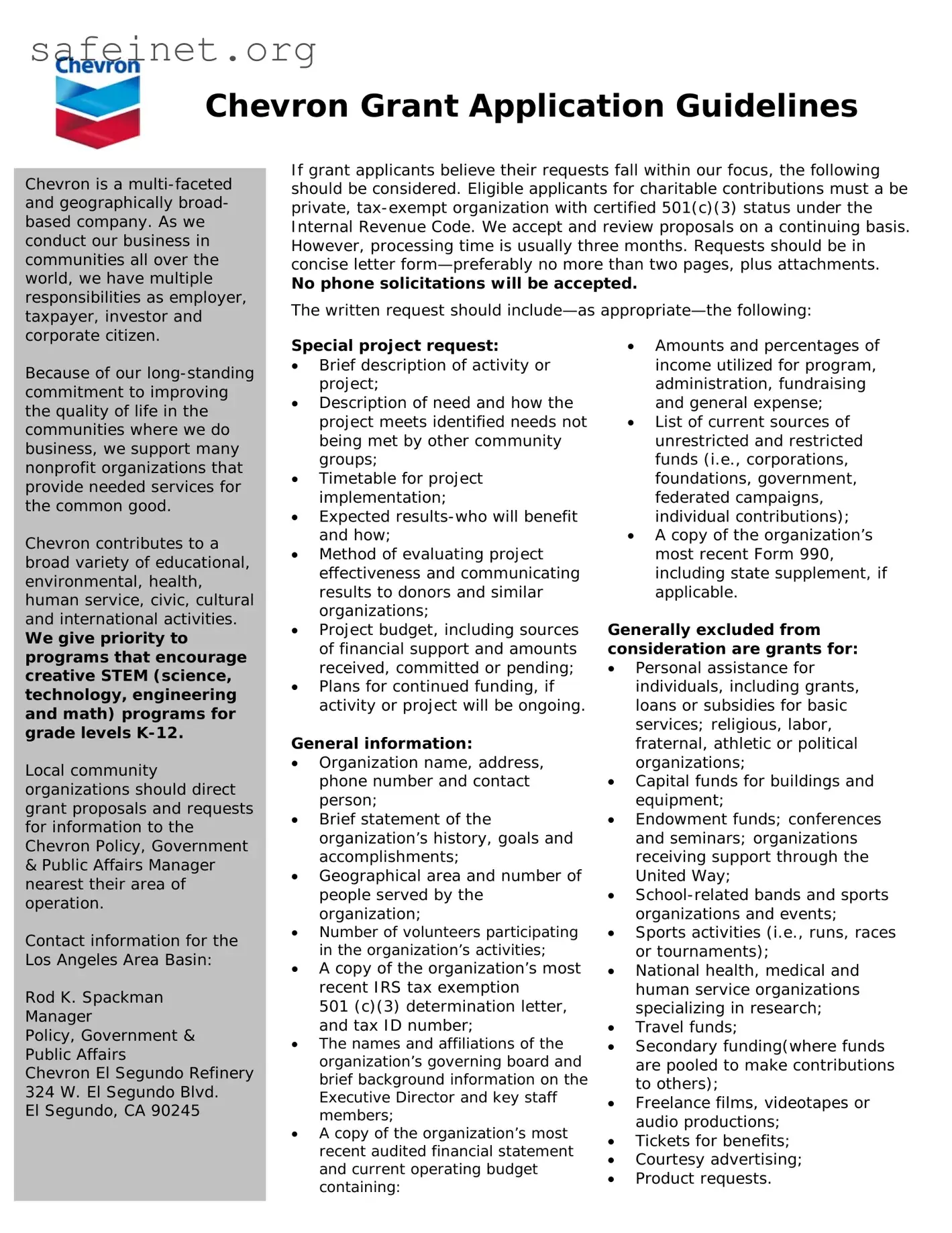Chevron is a multi-faceted and geographically broad- based company. As we conduct our business in communities all over the world, we have multiple responsibilities as employer, taxpayer, investor and corporate citizen.
If grant applicants believe their requests fall within our focus, the following should be considered. Eligible applicants for charitable contributions must a be private, tax-exempt organization with certified 501(c)(3) status under the Internal Revenue Code. We accept and review proposals on a continuing basis. However, processing time is usually three months. Requests should be in concise letter form—preferably no more than two pages, plus attachments.
No phone solicitations will be accepted.
The written request should include—as appropriate—the following:
Because of our long-standing commitment to improving the quality of life in the communities where we do business, we support many nonprofit organizations that provide needed services for the common good.
Chevron contributes to a broad variety of educational, environmental, health, human service, civic, cultural and international activities.
We give priority to programs that encourage creative STEM (science, technology, engineering and math) programs for grade levels K-12.
Local community organizations should direct grant proposals and requests for information to the Chevron Policy, Government
&Public Affairs Manager nearest their area of operation.
Contact information for the Los Angeles Area Basin:
Rod K. Spackman
Manager
Policy, Government &
Public Affairs
Chevron El Segundo Refinery
324 W. El Segundo Blvd.
El Segundo, CA 90245
Special project request:
•Brief description of activity or project;
•Description of need and how the project meets identified needs not being met by other community groups;
•Timetable for project implementation;
•Expected results-who will benefit and how;
•Method of evaluating project effectiveness and communicating results to donors and similar organizations;
•Project budget, including sources of financial support and amounts received, committed or pending;
•Plans for continued funding, if activity or project will be ongoing.
General information:
•Organization name, address, phone number and contact person;
•Brief statement of the organization’s history, goals and accomplishments;
•Geographical area and number of people served by the organization;
•Number of volunteers participating in the organization’s activities;
•A copy of the organization’s most recent IRS tax exemption
501 (c)(3) determination letter, and tax ID number;
•The names and affiliations of the organization’s governing board and brief background information on the Executive Director and key staff members;
•A copy of the organization’s most recent audited financial statement and current operating budget containing:
•Amounts and percentages of income utilized for program, administration, fundraising and general expense;
•List of current sources of unrestricted and restricted funds (i.e., corporations, foundations, government, federated campaigns, individual contributions);
•A copy of the organization’s most recent Form 990, including state supplement, if applicable.
Generally excluded from consideration are grants for:
•Personal assistance for individuals, including grants, loans or subsidies for basic services; religious, labor, fraternal, athletic or political organizations;
•Capital funds for buildings and equipment;
•Endowment funds; conferences and seminars; organizations receiving support through the United Way;
•School-related bands and sports organizations and events;
•Sports activities (i.e., runs, races or tournaments);
•National health, medical and human service organizations specializing in research;
•Travel funds;
•Secondary funding(where funds are pooled to make contributions to others);
•Freelance films, videotapes or audio productions;
•Tickets for benefits;
•Courtesy advertising;
•Product requests.

